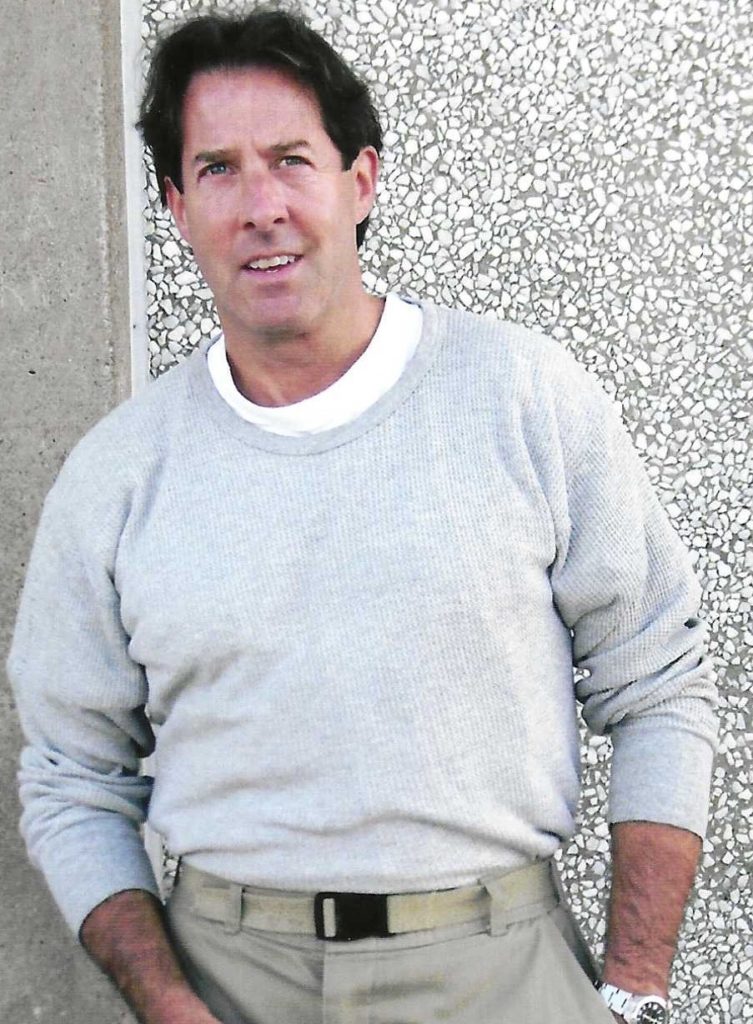When I began my interview with Inmate Brett Ellis, he introduced himself by saying, matter-of-factly, “I’m CONVICT-19, and I tested positive.”
Perplexed and somewhat confused, I responded, “You mean COVID-19.”
To which he immediately corrected me insisting, “No, CONVICT-19. That’s what the marshals and the guards call me, and that was before I tested positive. In fact,” he continued, “I’m only in prison for 19 days, so getting COVID was about the only thing I had time to do.”
CONVICT-19’s story is so surreal that it is almost too difficult to believe, even if it had been conceived as a movie script. The sad truth is our American judicial system has been generating these “Frankenstein-like” CONVICT-19s all over the country. It seems to have become an epidemic.
CONVICT-19 is Federal Inmate 22319-031, and he happened to arrive as the last of 19 inmates off the prison transport bus. As the intake guards at Receiving & Discharge (R&D) conducted roll call, each prisoner entering the building would be initially identified by his seat number as he disembarked. Brett was number 19 out of 19 prisoners arriving, so they called him “19”. Coincidentally, the prison officially uses the last two digits of a prisoner’s primary number to separate inmates into manageable groups for processing and services. Brett’s number happened to be 22319, and he recalled moving through issue and dress-out while being summoned at each stop: “Yo, 19! Uniform pick-up, now!” “19! Commissary up!” “Where’s 19? Boots and laces! Take ’em or leave ’em! Let’s go, 19!”
CONVICT-19 was sent back to prison on a supervised release (probation) violation for having the name and phone number of another felon, his best friend, listed on his smartphone. Of course, Brett was permitted to have the phone, but he had not received permission from probation to have his best friend’s name and number as a contact. For this infraction, Brett would be subject to a massive investigation, a revocation hearing, a probation violation, and a newly imposed sentence of six months in prison. It would take the system five and a half months just to deliver him from his home in Gardner, Kansas to Seagoville, Texas – his assigned custody location. After several endless bus rides, private prison overnights, nationwide airlifts, and van transports, he would only have 19 days left to serve in prison. Back in Kansas, he asked the U.S. Marshals why he could not just stay at the private prison, CoreCivic-Leavenworth, where he started, to which, the officer responded, “Everyone’s gotta eat.”
CONVICT-19 had been originally arrested in 2009, but all things considered, he was not “the guy”. He was never “the guy”. In fact, even when they prosecuted him, he really wasn’t “the guy”. Yeah, he was guilty alright, but he had never been in trouble with the law, he had no criminal history, he had no violence, he had no hands-on victim within his charge. When he was arrested, all he wanted to do was accept responsibility, plead guilty, serve his time in good faith, and return home. The system, however, would simply not allow that – after all, he WAS “the guy”. The system had other plans for him. It seems that once this finely tuned, well-oiled machine we call ‘criminal justice’ got its hooks into this fresh meat, it would not stop churning and processing like a sausage grinder until it had turned Brett Ellis into the unrecognizable and extremely expensive, “CONVICT-19”.
CONVICT-19’s story is an example of a broken judicial system and an unbridled prison industrial complex. This massive sausage-making machine is rife with moving parts that include deep-cutting congressional statutes, long-rolling draconian sentences, life-altering punitive measures for non-violent offenders, and tightly packed prison facilities that crush all hope and fail to rehabilitate or release people based on merit or accomplishment. Once someone is finally released, the end product is often returned to the factory (prison) in the form of high recidivism – usually as spoiled goods. No worries, however, there seems to be an endless supply of new detainees to feed into the grinder. After all, “Everyone’s gotta eat.”
CONVICT-19 had been initially arrested eleven years previous for possession of an illicit image depicting a minor that was recovered from his computer’s hard drive. The image was captured from an illegal website that he may or may not have visited – he simply could not remember. He admitted that he had clicked on and out of a plethora of taboo websites. Nevertheless, as far as criminal justice was concerned, it WAS his hard drive, it WAS at his residence, he HAD been surfing the net, and in Orwellian style, he WOULD be fed into the sausage grinder for possession of this inappropriate contraband. Brett accepted his fate, he took responsibility, he cooperated fully, and he agreed to plead guilty to put all this behind him. Unfortunately, American justice does not allow for an efficient prosecution when so many departments, agencies, and civil servants, all “gotta eat”.
CONVICT-19 started this long and arduous criminal proceeding in 2009, when agents first arrived on his doorstep – eleven men deep, guns drawn, battering ram deployed, chaos and pandemonium, as officers screamed, “Get on the ground!”
The first question Brett asked himself was, “How did they know which websites I had visited?” It turns out, they knew. The Feds’ international cyber-crimes taskforce had been watching his surfing activities for more than two years before they orchestrated this siege. The approximate cost to execute the investigation and launch a multi-agency deployment would exceed $56,400[1].
CONVICT-19 would be scooped up and escorted by the tactical team, and he would be delivered to CoreCivic-Leavenworth not far from his home. While housed under a federal government contract over the next few months, he would await his fate. The marshals would begin a series of transports to and from the federal court as part of the arraignment process. Brett would be returned in five months for his official plea hearing. He would sit around at the holdover for another nine months, until the date of his formal sentencing hearing. Finally, he would receive a term of six years imprisonment for what the court would describe as egregious and inappropriate behavior. His prosecution alone cost taxpayers about $163,900[2].
CONVICT-19 would be transferred by bus, airlift, and transport van in 2012, to his destination at Federal Correctional Institution La Tuna, New Mexico, where he would serve out his original sentence. Others at La Tuna serving time for similar “non-contact” computer offenses commiserated about prison terms exceeding twelve, fifteen, even twenty years. Six years, Brett thought, must be a walk in the park. Nevertheless, the cost to American taxpayers for this individual prison term alone was $216,000[3], and that would be a mere drop in the bucket when added to the cost of another 14,674 non-contact “computer clickers” housed throughout the federal system[4].
CONVICT-19 would eventually complete his term of imprisonment in February 2018 and be released as a model inmate. He would be returned home with no infractions, no violations, but with no formal rehabilitation or behavioral counseling except that which he initiated on his own. Despite having only a 1.5% chance of reoffending, he would face a 63% chance of returning to prison on a non-offense violation, so he intended to “walk on eggshells”. Upon release, he would begin his eight years of supervision under the watchful eye of the United States Office of Probation, and at a cost of no less than $39,956[5]. He would become one of nearly a million individuals on the Registry. After all, “Everyone’s gotta eat.”
CONVICT-19 eventually landed full-time employment in 2018 at a neighborhood grocery store. He attended all his required behavioral therapy meetings, he adhered to his electronic monitoring obligations, he sat for random polygraph exams, and he consistently reported to his Eastern District probation officer. As a precaution for those fellow-employees and grocery customers, Brett would meticulously follow all COVID-related protocols, including wearing a mask, social distancing, washing his hands, and receiving intermittent testing. He was absolutely, positively, unequivocally “COVID-19-negative” when the assault team arrived on his doorstep later that day.
Earlier in the day, CONVICT-19 had punched into work as usual, but today things felt different. His co-worker of two years, a young woman in the neighborhood, seemed to be glaring at him with disdain. The evening before, she had checked the local Registry and found his name listed. In her rage, her fear, and disgust, she immediately contacted the local probation office to warn them, “Brett Ellis has possession of a smartphone and is likely misusing it while on the Registry.” The Office of Probation immediately formulated a taskforce to investigate. They dispatched an extraction team to Brett’s home to intercept the phone.
When Brett arrived home from work, they were waiting, hungry, and in full tactical regalia. Even though Brett immediately offered up his phone and explained that he had permission to own one, the team proceeded to escort him to the federal building, subject him to a series of polygraph tests, rephrase questions five different ways, and interrogate him on whether he had utilized the phone for nefarious purposes. The polygraph produced three truthful responses, two deceptive responses, and one inconclusive response. Brett insisted he only used the phone to call friends.
CONVICT-19’s phone was then subject to an extensive forensic evaluation which found nothing unusual. Eventually, a scroll through the contact list did produce the name and number of the best friend, a known and identified felon. Nearing the conclusion of this comprehensive investigation, Brett thought to himself, Why did they not just ask me if I had a felon’s name on my phone? I would have told them. Nevertheless, the investigation ensued, departments participated, reports were drafted, and the system closed in on its prey at a cost of more than $12,975[6].
CONVICT-19 was certain he would not be transferred anywhere during the peak of a global pandemic. His confidence was based on a recent memo announcing that both the U.S. Marshals and the Federal Bureau of Prisons (BOP) would discontinue all non-essential prisoner transfers to minimize undue exposure. However, Brett found himself on a transport bus within days.
CONVICT-19, at the peak of the epidemic in mid-July 2020, found himself in the company of thousands of other prisoners all in transit to and from various prisons. He began at the private prison, CoreCivic-Leavenworth, waiting for his official revocation hearing. That hearing would be attended by a flurry of masked court personnel, investigative agents, socially distant prosecutors, and gloved U.S. Marshals, each carrying files bearing number 22319-031. The defendant would be sentenced to a term of six months imprisonment in Seagoville, Texas, at a cost of $18,000[7].
CONVICT-19 would begin his new prison assignment traveling from Leavenworth, by van, to the airport. He would then depart by airlift and cross country to and from Phoenix, collecting hundreds of transferees, men, and women, along the way. Transport vans would shuttle him to various overnights, supporting a network of private prisons and contract jails, and eventually return to Oklahoma, just a few hundred miles from where he began in Kansas. His temporary home would be the newly renovated private prison, CoreCivic-Cimarron. Remember, thought Brett, bus drivers, air marshals, county sheriffs: “they all gotta eat”.
CONVICT-19 would remain at Cimarron, enjoying the new paint smell, for a month or so before he would eventually begin another series of transports. All while the pandemic continued to rage on. The Department of Justice (DOJ) and BOP continued reporting that all prisoner transports were on-hold for safety purposes. Federal Correctional Institution (FCI) Seagoville, Brett’s ultimate destination, just happened to be identified as the single most concentrated population for COVID-positive cases of any institution, company, hospital, food processing plant, or stand-alone facility in the world.
CONVICT-19 would eventually arrive in the last seat on a 19-person transport, and he would enter the gates of the Seagoville Federal Holdover on November 6, 2020, nearly five months after he began his violation. He would be placed in a holding cell with three other temporary inmates, and his cell would transition new prisoners in and out daily. Within a few weeks, there would be eighteen different prisoners sharing these bunks, most “non-contact computer clickers”.
This prompted Brett to ask a guard, “Why so many clickers?”
To which the guard responded with elation, “Hell, you guys are the new marijuana!”
CONVICT-19 would finally walk across the street in early-December 2020 and, for the very first time, step onto the grounds of FCI Seagoville, where he would begin his official prison term. He would be housed in a dorm-style building with 320 men, and placed into the very same bunk of Inmate Jared Marvin who, just an hour before, was removed from that ten-man cell because he had tested positive for COVID-19 after experiencing flu-like symptoms. If history has a way of repeating itself, it was almost as though the government “issued a smallpox-laden blanket” to this hapless native named Brett Ellis.
CONVICT-19 would test positive within 36 hours of his arrival. Two-thirds of his ten-man cell would test positive with him. He would satisfy his prison sentence over the next 19 days, only to be returned home on December 30th with a debilitating virus. Unfortunately, this time, he would return, not as “Brett Ellis”, but rather as the $421,831 “CONVICT-19”. He would return having no home, no job, no money, and no best friend to call. He would arrive hungry but soon realize, “not everyone’s gotta eat.”
[1] Approximation: Avg. cost of taskforce/SWAT, 2009, 11-member at $26/hr, 6-hr sweep, $2,234, plus amortization of $3.9m SWAT annual budget over 72 calls/year, $54,166 for approximate total: $56,400.
[2] Approximation: Fed.Dist.Crt. criminal info/indictment, Grnd. jury empanel, U.S.Attorn./AUSA prosec./15 months, 290hrs., Fed.Dist.Crt. plea hearing, Prob.Offic., Intrv./PSI/PSR, Fed.Dist.Crt. sent.hearing, Marshals’ proces., at approximate cost of $163,900.
[3] Approximation: Avg. BOP annual cost/per inmate, $36,000 at 72 month/term, for approximate total: $216,000.
[4] Approximation: 2019 BOP.gov/sex offender popul., 15,947 at 92% “non-contact/computer” offenses, for an approximate total of 14,674.
[5] Approximation: Avg. U.S. Probation Officer/hr at $33, 2hr/week supervision, annual $3,432, over 8 yrs., $27,456 plus amortization of $2.4m operation/equip annual budget over approx. 1,600 probates, $1,562.50, over 8 yrs., $12,500, for approximate total: $39,956.
[6] Approximation: Avg. forensic/revocation investigation, annual amortization of $450,000 budget, $234.37/hr at 40hrs., $9,375 plus revocation/hearing costs $3,600, for approximate total: $12,975.
[7] Approximation: Avg. BOP annual cost/$36,000 per inmate, at 6 month/term, for approximate total: $18,000.





No Comments